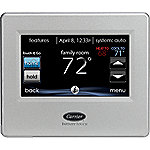THERMOSTAT SETBACKS SAVE MONEY FACT OR FICTION

Does Turning Down the Thermostat Save Money? Here’s the Truth
The internet is full of conflicting advice, especially when it comes to saving money on energy bills. For homeowners trying to reduce their heating costs during the winter, it can be tough to separate legitimate tips from myths. One common piece of misinformation involves thermostat setbacks (turning your thermostat down by about 8 degrees for at least 8 hours, typically at night or when you're away from home). Here’s a myth we’ve seen floating around:
"Thermostat setbacks during the winter won’t save you money. Any energy you save when the thermostat is turned down will be lost because of the amount of fuel your furnace needs to bring your home back to a comfortable temperature."
Let’s set the record straight: this is incorrect. Thermostat setbacks do save money. Let’s explore why.
Why Thermostat Setbacks Save Energy
It’s true that your furnace will need to work harder and run longer to bring your home back to a comfortable temperature after a setback. However, this doesn’t mean setbacks aren’t cost-effective. In fact, your overall energy usage will still decrease. Why? Because of a fundamental principle of heat transfer.
When you lower the temperature of your home, its rate of heat loss decreases. Heat flows from warmer areas to colder ones, and the speed of this transfer depends on the difference in temperature between your home and the outside. Lowering your thermostat reduces that difference, slowing down heat loss. Energy.gov explains it perfectly:
“[A]s soon as your house drops below its normal temperature, it will lose energy to the surrounding environment more slowly. The lower the interior temperature, the slower the heat loss. So, the longer your house remains at the lower temperature, the more energy you save, because your house has lost less energy than it would have at the higher temperature.”
In practical terms, setting your thermostat to 64°F while you're away instead of leaving it at 72°F results in your furnace running less often, which translates into savings.
What the Studies Say
Multiple studies confirm the benefits of thermostat setbacks. For example, the Canadian Centre for Housing Technology found that thermostat setbacks are an effective and inexpensive way to save energy—even in energy-efficient homes. However, the amount you save depends on factors like the outdoor temperature, the efficiency of your heating system, and how well your home is insulated.
If you live in a colder climate, your savings from setbacks can be even greater because heat loss occurs more rapidly at higher indoor temperatures compared to the frigid outdoors. This makes setbacks particularly beneficial during bitterly cold winter nights.
The Convenience of Programmable Thermostats
The ideal times for thermostat setbacks are when you’re asleep or away from home for extended periods, such as during work hours. These are typically 8-hour stretches when maintaining a high indoor temperature isn’t as important.
Manually adjusting your thermostat every day can be a hassle, but programmable thermostats make it easy to schedule temperature changes automatically. Here are a few popular options:
- 5-2 Day Model: Create one schedule for weekdays and another for the weekend.
- 5-1-1 Day Model: Customize three schedules—one for weekdays, one for Saturday, and one for Sunday.
- 7-Day Model: Create a unique schedule for each day of the week. If you have an irregular routine, this model offers the most flexibility.
Smart thermostats, such as those from Nest or Ecobee, take this convenience to the next level by learning your habits over time and optimizing temperature settings for maximum efficiency.
What’s the Best Temperature for Saving Money in Winter?
To maximize savings, aim to keep your thermostat set to around 68°F while you’re awake and lower it by 7-10°F while you’re sleeping or away from home. According to Energy.gov, following this practice consistently can save you up to 10% annually on heating costs.
The Bottom Line
Turning down your thermostat at night or while you're away is a proven way to save money on your heating bills. By reducing your home’s rate of heat loss and running your furnace less often, thermostat setbacks are an easy and effective energy-saving strategy.
For even more savings and convenience, consider upgrading to a programmable or smart thermostat. And remember: small adjustments in your thermostat settings can add up to big savings over time—especially during the coldest months of the year.
If you have questions about programmable thermostats or optimizing your HVAC system for energy efficiency, contact us today. Ragsdale is here to help keep your Atlanta area home comfortable and save money all winter long.
Related Reading
Join Our Email Newsletter
Receive updates, current news, promotions, and industry tips.
